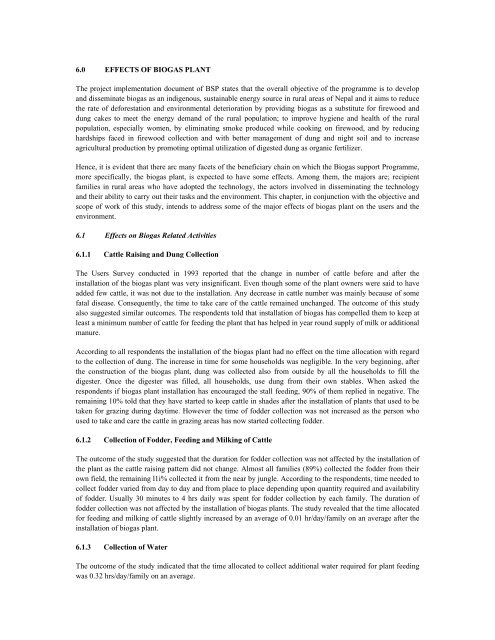download (pdf, 11MB) - SNV
download (pdf, 11MB) - SNV
download (pdf, 11MB) - SNV
You also want an ePaper? Increase the reach of your titles
YUMPU automatically turns print PDFs into web optimized ePapers that Google loves.
6.0 EFFECTS OF BIOGAS PLANT<br />
The project implementation document of BSP states that the overall objective of the programme is to develop<br />
and disseminate biogas as an indigenous, sustainable energy source in rural areas of Nepal and it aims to reduce<br />
the rate of deforestation and environmental deterioration by providing biogas as a substitute for firewood and<br />
dung cakes to meet the energy demand of the rural population; to improve hygiene and health of the rural<br />
population, especially women, by eliminating smoke produced while cooking on firewood, and by reducing<br />
hardships faced in firewood collection and with better management of dung and night soil and to increase<br />
agricultural production by promoting optimal utilization of digested dung as organic fertilizer.<br />
Hence, it is evident that there arc many facets of the beneficiary chain on which the Biogas support Programme,<br />
more specifically, the biogas plant, is expected to have some effects. Among them, the majors are; recipient<br />
families in rural areas who have adopted the technology, the actors involved in disseminating the technology<br />
and their ability to carry out their tasks and the environment. This chapter, in conjunction with the objective and<br />
scope of work of this study, intends to address some of the major effects of biogas plant on the users and the<br />
environment.<br />
6.1 Effects on Biogas Related Activities<br />
6.1.1 Cattle Raising and Dung Collection<br />
The Users Survey conducted in 1993 reported that the change in number of cattle before and after the<br />
installation of the biogas plant was very insignificant. Even though some of the plant owners were said to have<br />
added few cattle, it was not due to the installation. Any decrease in cattle number was mainly because of some<br />
fatal disease. Consequently, the time to take care of the cattle remained unchanged. The outcome of this study<br />
also suggested similar outcomes. The respondents told that installation of biogas has compelled them to keep at<br />
least a minimum number of cattle for feeding the plant that has helped in year round supply of milk or additional<br />
manure.<br />
According to all respondents the installation of the biogas plant had no effect on the time allocation with regard<br />
to the collection of dung. The increase in time for some households was negligible. In the very beginning, after<br />
the construction of the biogas plant, dung was collected also from outside by all the households to fill the<br />
digester. Once the digester was filled, all households, use dung from their own stables. When asked the<br />
respondents if biogas plant installation has encouraged the stall feeding, 90% of them replied in negative. The<br />
remaining 10% told that they have started to keep cattle in shades after the installation of plants that used to be<br />
taken for grazing during daytime. However the time of fodder collection was not increased as the person who<br />
used to take and care the cattle in grazing areas has now started collecting fodder.<br />
6.1.2 Collection of Fodder, Feeding and Milking of Cattle<br />
The outcome of the study suggested that the duration for fodder collection was not affected by the installation of<br />
the plant as the cattle raising pattern did not change. Almost all families (89%) collected the fodder from their<br />
own field, the remaining l1i% collected it from the near by jungle. According to the respondents, time needed to<br />
collect fodder varied from day to day and from place to place depending upon quantity required and availability<br />
of fodder. Usually 30 minutes to 4 hrs daily was spent for fodder collection by each family. The duration of<br />
fodder collection was not affected by the installation of biogas plants. The study revealed that the time allocated<br />
for feeding and milking of cattle slightly increased by an average of 0.01 hr/day/family on an average after the<br />
installation of biogas plant.<br />
6.1.3 Collection of Water<br />
The outcome of the study indicated that the time allocated to collect additional water required for plant feeding<br />
was 0.32 hrs/day/family on an average.
















